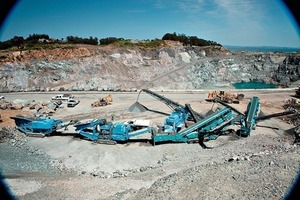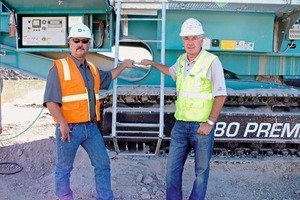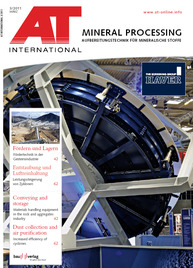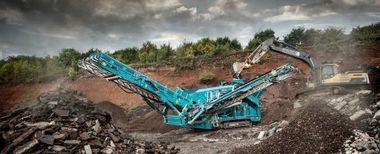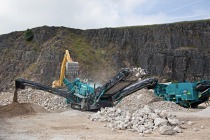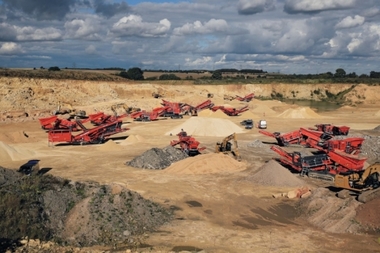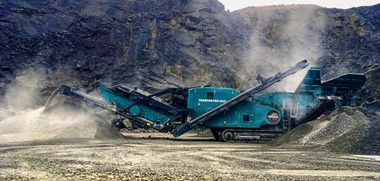Revolution in quarry and recycling operations
For the past 12 years, the Dutra Group, Richmond, CA/USA had been using a portable, wheel-mounted, electric-powered crushing/screening/conveying system that they transported about four times a year between their basalt (blue rock) quarry at San Rafael and their concrete recycling yards at Richmond as well as two former sites. All are located in the San Francisco Bay Area and range from 15-35 miles apart. When sufficient material stockpiles were built up at the quarry, the equipment was moved to one of the recycling yards to crush anywhere from 60 000-80 000 t of rubble; then on to another yard or back to the quarry. Each move required four or more men and 11 truckloads, including towing two crushers and a screen, and took 11 days.
In February 2010, Dutra switched to a diesel-powered, track-mounted Powerscreen® crushing and screening system that requires only two men, four trucks and two days for each move. In addition, the new system has substantially increased material production at all sites and has dramatically reduced costs overall. “The old system was too complicated, cumbersome, and was costing us too much in lost production time, maintenance time and expense, and moving costs,” says Quarry Manager Jon Guglielmini. “Each move cost about 25 000 US$ one way, or 100 000 US$ for four annual moves. In addition, we lost a total of 44 production days for four moves. With the new system, each move costs about 10 000 US$, or 40 000 US$ total for four moves, and we lose only eight production days total”.
The old system included a jaw crusher, apron feeder, cone crusher, a side conveyor, a return conveyor to the cone, a screen-feed conveyor, a screening plant, two 60’ land conveyors, a 125’ radial stacker, several chutes, and a generator. The new Powerscreen® system includes an 1180 Premiertrak jaw crusher, two 1300 Maxtrak Automax® cone crushers, a Chieftain 2100X double-deck dry screen, a Chieftain 2100X triple-deck dry screen, and a track conveyor (Fig. 1). The 1180 Premiertrak jaw is designed for high output in quarrying and recycling applications. It features excellent reduction, low fuel consumption, high mobility, plus simplified setup, operation and maintenance. The 1300 cone excels in production of sub-base and aggregates, with excellent cubicity, throughput and reduction ratios. The Chieftain 2100 is designed for large volumes of high specification products. The three-deck version has a patented hydraulically folding re-circulating conveyor, eliminating the need for a crane on site.
At the quarry, the jaw feeds the primary cone directly, with no need for a screen plant in between. Material then goes to the two-deck screen, with oversize going on to the secondary cone under the reject side to be re-crushed and go back to the two-deck screen. The rest goes to the three-deck screen for distribution to four stockpiles: 3/4“, 1/2“, 3/8“ and quarry dust (3/16 x 0).
“The new system is much more versatile,” Guglielmini says. “At the rock quarry, we use all six pieces of equipment. But we need only four at the recycling yard: the jaw, the cone, the 2100 double-deck, and a stacker conveyor. At the yard we produce 3/4“ base material and 3/4“ drain, which is clean – no dirt. We also make manufactured sand by using the jaw, cone and screen in closed circuit. The new tracked system is also much more efficient. This is equipment that likes to be fed constantly. When we do, we can get production of up to 360 t/h in the quarry. Our daily goal is at least 3000 t, and we normally achieve 3200 t with the new system. With the old system, we might have gotten 3000 t three times in 12 years.”
Powerscreen, Dungannon (NI),
Tel.: +44 28 877 18500,

